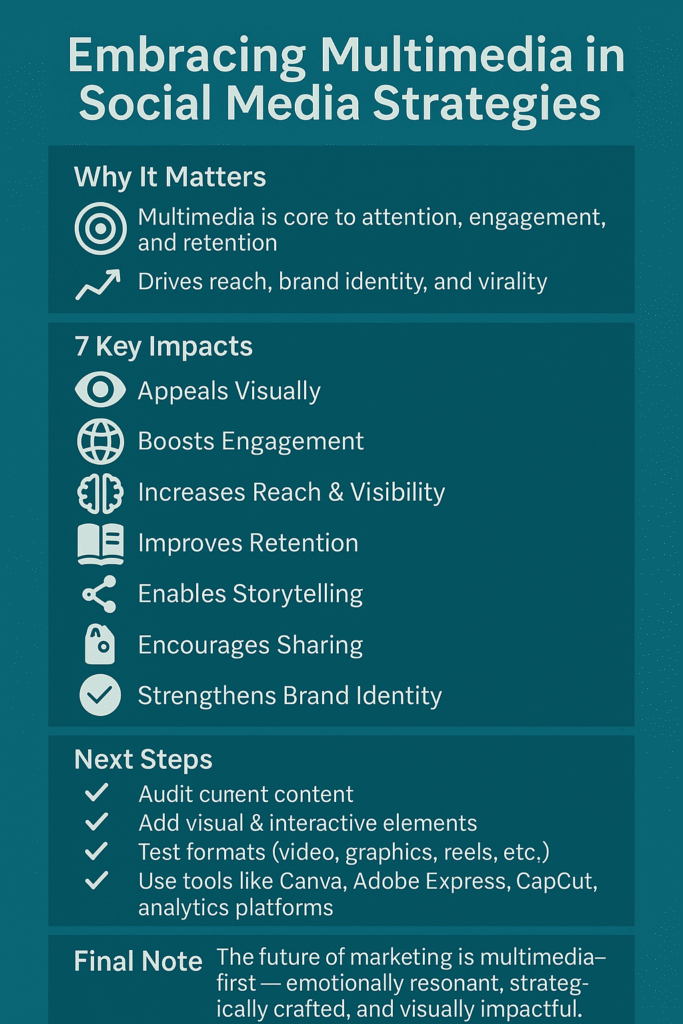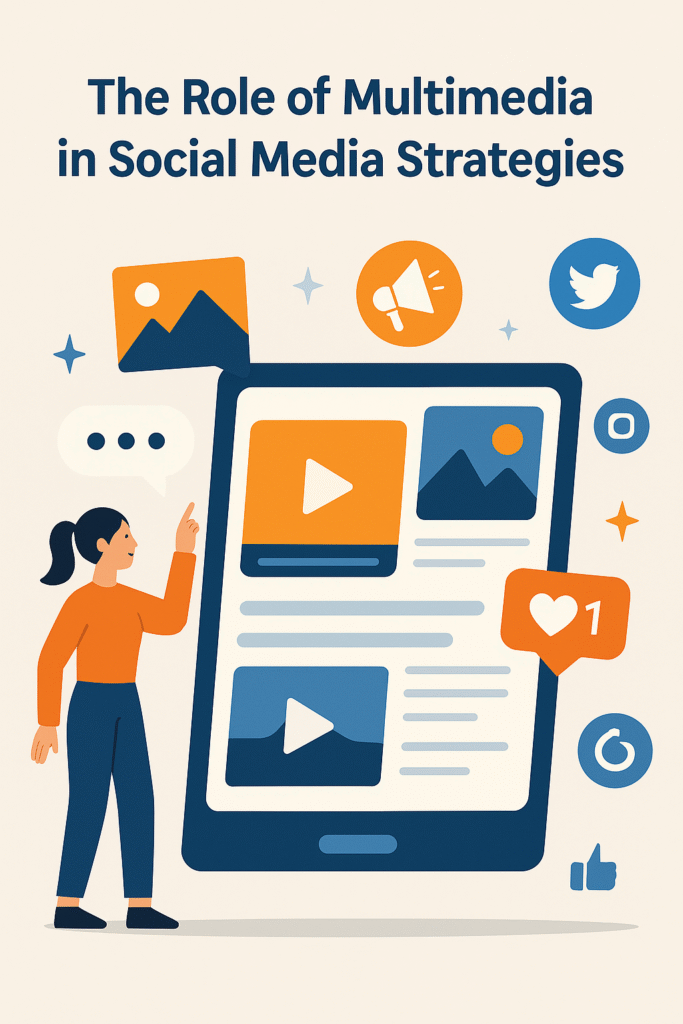In today’s fast-paced digital world, capturing your audience’s attention has become more challenging than ever. Are you struggling to make your social media content stand out in the crowded online space? You’re not alone. With millions of posts shared every minute across various platforms, businesses and content creators are constantly seeking innovative ways to engage their audience effectively.
The secret lies in understanding how multimedia in social media can revolutionise your approach to digital marketing. From eye-catching visuals to engaging videos, multimedia content has become the backbone of successful social media strategies. This comprehensive guide explores the transformative power of multimedia and how it can elevate your brand’s online presence.
Table of Contents
Multimedia in Social Media

Multimedia in social media refers to the integration of various content formats, including images, videos, audio, graphics, animations, and interactive elements within social media platforms. Unlike traditional text-based content, multimedia creates a rich, immersive experience that resonates with users on multiple sensory levels.
The evolution of social media platforms has made multimedia content not just an option but a necessity for effective communication. Modern audiences expect visually appealing, dynamic content that entertains while informing. This shift has fundamentally changed how brands approach their social media marketing strategies.
Today’s social media landscape is dominated by visual-first platforms like Instagram, TikTok, and YouTube, which have proven that multimedia content generates significantly higher engagement rates compared to text-only posts. Understanding this trend is crucial for anyone looking to build a strong online presence.
Impact of Multimedia in Social Media Strategies
The integration of multimedia elements into social media strategies creates a ripple effect that transforms how audiences interact with content. Let’s explore the seven key impacts that make multimedia an indispensable tool for modern digital marketing.
Appealing to Users
Visual content naturally draws the human eye, making multimedia an instant attention-grabber in busy social media feeds. Our brains process visual information 60,000 times faster than text, which explains why posts with images receive 94% more views than text-only content.
Consider how Netflix uses vibrant movie posters and trailer previews on their social media accounts. These visual elements immediately communicate the essence of their content, making users more likely to engage with their posts. Similarly, food brands like Tasty have built massive followings by sharing visually appealing recipe videos that make viewers crave their dishes.
The psychological appeal of multimedia content stems from its ability to trigger emotional responses. A well-crafted infographic can simplify complex information, while a compelling video can tell a story that resonates with viewers’ experiences. This emotional connection is what transforms casual scrollers into engaged followers and potential customers.
Boosts Engagement
Multimedia content consistently outperforms text-based posts in terms of likes, comments, shares, and overall engagement. Video content, in particular, has shown remarkable results, with social media posts containing videos generating 1,200% more shares than text and image posts combined.
Take the example of Dove’s “Real Beauty” campaign, which uses authentic photos and videos of real women to promote body positivity. This multimedia approach has generated millions of interactions across platforms, with users sharing their own stories and experiences in the comments. The campaign’s success demonstrates how multimedia can create meaningful conversations around brand values.
Interactive multimedia elements like polls, quizzes, and live videos further enhance engagement by encouraging active participation from users. Instagram Stories’ interactive features have proven particularly effective, with brands reporting up to 70% higher engagement rates when using polls and question stickers compared to static story posts.
Increase Reach & Visibility
Social media algorithms favour multimedia content, particularly videos, which means these posts are more likely to appear in users’ feeds and reach a broader audience. Platforms like Facebook and Instagram prioritise video content in their algorithms, often showing videos to 135% more people than photo posts.
The viral nature of multimedia content contributes significantly to organic reach expansion. When users share visually appealing content, it exposes brands to new audiences without additional advertising costs. Memes, infographics, and short-form videos are particularly effective at achieving viral status due to their shareability factor.
Cross-platform compatibility also enhances reach, as multimedia content can be easily adapted and shared across different social media channels. A single video can be shared on YouTube, Instagram, TikTok, and Facebook with platform-specific optimisations, maximising exposure with minimal additional effort.
Improve Information Retention
The human brain retains visual information significantly better than text alone. Studies show that people remember 65% of visual information three days later, compared to only 10% of text-based information. This makes multimedia content invaluable for educational content, product demonstrations, and brand messaging.
Educational technology companies like Khan Academy leverage this principle by creating animated explainer videos that break down complex concepts into digestible visual formats. Their multimedia approach has helped millions of students understand difficult subjects more effectively than traditional text-based learning materials.
Infographics represent another powerful tool for information retention, combining statistical data with visual elements to create memorable content. Companies sharing industry insights through well-designed infographics often see these posts saved and referenced long after their initial publication, extending their content’s lifespan and value.
Impactful Storytelling
Multimedia enables brands to tell compelling stories that resonate with their audience on an emotional level. The combination of visuals, audio, and text creates a multi-sensory experience that can convey complex narratives more effectively than any single medium alone.
Nike’s marketing campaigns exemplify masterful multimedia storytelling. Their “Just Do It” campaigns combine powerful imagery, inspiring music, and compelling narratives about overcoming challenges. These multimedia stories don’t just sell products; they sell aspirations and connect with viewers’ personal journeys.
User-generated content (UGC) campaigns also benefit from multimedia storytelling. When customers share photos and videos of themselves using products, they create authentic narratives that other potential customers can relate to. This peer-to-peer storytelling through multimedia content often proves more influential than traditional advertising.
Easy Sharing and Virality
The shareable nature of multimedia content makes it a powerful tool for expanding brand reach organically. Visual content is shared 40 times more frequently than text-based content, making it an essential component of any viral marketing strategy.
Memes and short-form videos have become the currency of social media sharing, with platforms like TikTok and Instagram Reels specifically designed to facilitate viral content distribution. Brands that successfully tap into trending multimedia formats often experience exponential growth in their follower base and engagement rates.
The key to creating shareable multimedia content lies in understanding current trends, platform-specific preferences, and audience behaviour. Content that evokes strong emotions, provides value, or entertains is more likely to be shared, creating a snowball effect that amplifies brand visibility.
Enhances Brand Identity
Consistent use of multimedia elements helps establish and reinforce brand identity across social media platforms. Visual consistency in colours, fonts, imagery style, and video aesthetics creates a cohesive brand experience that makes businesses instantly recognisable to their audience.
Apple’s social media presence exemplifies a strong brand identity through multimedia. Their clean, minimalist visual style, consistent colour palette, and high-quality product photography create a distinctive brand aesthetic that aligns with their premium positioning. This consistency helps users immediately identify Apple content in their feeds.
Video content offers unique opportunities for brand personality expression through tone of voice, music choices, and visual style. Brands like Old Spice have built distinctive identities through quirky, humorous video content that reflects their playful brand personality and appeals to their target demographic.

Conclusion
The role of multimedia in social media strategies cannot be overstated in today’s digital landscape. From capturing initial attention to driving engagement, improving information retention, and building strong brand identities, multimedia content has become the cornerstone of successful social media marketing.
As we’ve explored, the seven key impacts of multimedia – appealing to users, boosting engagement, increasing reach and visibility, improving information retention, enabling impactful storytelling, facilitating easy sharing and virality, and enhancing brand identity – work together to create a comprehensive approach to digital marketing success.
The future of social media marketing lies in creating authentic, engaging multimedia experiences that resonate with audiences on emotional and practical levels. Brands that embrace this multimedia-first approach will find themselves better positioned to build meaningful connections with their target audience, drive business results, and stay competitive in an increasingly crowded digital marketplace.
Ready to transform your social media strategy with multimedia? Start by auditing your current content mix, identifying opportunities for visual enhancement, and experimenting with different multimedia formats. Remember, the most successful social media strategies are those that consistently deliver value through engaging, well-crafted multimedia content.
For more insights on developing effective digital marketing strategies, consider exploring advanced multimedia tools and techniques that can further elevate your social media presence.
FAQs
Q: What types of multimedia content work best for social media?
A: Video content consistently performs best across platforms, followed by high-quality images, infographics, and interactive content like polls and live streams. The key is matching content type to platform preferences and audience behaviour.
Q: How often should I post multimedia content on social media?
A: Consistency is more important than frequency. Aim for regular posting schedules with high-quality multimedia content rather than overwhelming your audience with frequent but low-quality posts. Most brands find success with 3-5 posts per week containing multimedia elements.
Q: Which social media platforms are best for multimedia content?
A: Instagram, TikTok, YouTube, and Facebook are particularly effective for multimedia content. Each platform has unique features and audience preferences, so tailor your multimedia strategy accordingly.
Q: How can small businesses create multimedia content on a budget?
A: Start with smartphone photography and video creation, use free design tools like Canva for graphics, and leverage user-generated content. Focus on creativity and authenticity rather than expensive production values.
Q: What are the key metrics to track for multimedia social media content?
A: Monitor engagement rates (likes, comments, shares), reach and impressions, video completion rates, click-through rates, and conversion rates. These metrics help determine which multimedia formats resonate most with your audience.
Q: How do I ensure my multimedia content is accessible to all users?
A: Include alt text for images, captions for videos, use high contrast colours, and ensure text is readable. Accessibility not only helps users with disabilities but also improves overall user experience and SEO performance.
